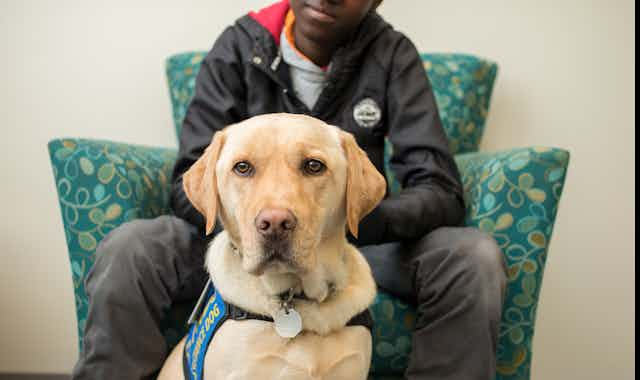When you’re a victim of crime, especially interpersonal abuse, sharing the truth about what happened is often terrifying. Imagine how much more difficult it is for children.
But today, in many communities, child victims and witnesses are being supported by a quiet, talented and empathetic group of workers — dogs. Justice facility dogs, to be precise.
The idea of enlisting dogs’ distinct skills and abilities is reflected in different kinds of canine care work. Specialized service dogs perform life-changing and life-sustaining work around the clock, helping people with many kinds of disabilities. Therapy dogs work part-time supporting people in hospitals, long-term care facilities and libraries.
American prosecutor Ellen O’Neill-Stephens and veterinarian Celeste Walsen wanted to enlist highly trained and accredited service dogs to assist children within the justice system, so they co-founded the Courthouse Dogs Foundation in the United States in 2008. The practice has since spread globally.
Dogs can help bolster public safety
Kim Gramlich of the Delta Police Victim Services in British Columbia created Justice Facility Dogs Canada and now more than 50 accredited dogs are at work around the country. Not only are these dogs doing impressive and important work supporting victims, but they are also facilitating more thorough investigations and prosecutions, thereby bolstering public safety.

The dogs sit and walk with children to support them. Handlers have countless moving examples of children who were initially too scared to speak to social workers or investigators, but who gained confidence and found their voices once they interacted with the dog.
When permission is obtained, the dogs can also sit directly with children as they testify in trial to provide strength and comfort for this intimidating experience.
The damage done by abuse is widespread and multifaceted, and justice facility dogs can also help with some of the lived effects of violence and harassment.
A particularly affecting example a handler shared with me involved a boy in a small town whose father had murdered his mother. The boy was scared to return to school and worried about what other kids would say. When the facility dog was permitted to join him on his first day back at school, the boy felt comfortable returning and the dog became a shield, a source of comfort and a beacon for positive interest from other children.
The dogs can assist survivors of intergenerational trauma, as well. Gramlich walked with Puma and people of the Tk’emlúps te Secwépemc First Nation and the Adams Lake Band to honour the 215 children whose bodies were found outside a residential school in Kamloops, B.C.
Dogs approach people under stress
The dogs are partnered with human professionals in victim services, children’s aid and law enforcement. The human partners are the dogs’ handlers and caretakers, at work and at home. But often the dogs will work independently and even approach people proactively who are experiencing great stress to offer comfort and care. I have witnessed this first-hand. The dogs’ ability to understand us and our true feelings is remarkable.
The positive impact of these dogs is undeniable, but some people wonder about how this work affects the animals. This is an essential question when we ask animals to work with and for us. It is particularly significant since we know dogs experience what is called emotional contagion — their stress levels often increase when they hear and see people in distress.
In fact, not only do we need to take animal well-being seriously while they are working, we also need to respect their work lives in the fullest sense — that is, to pay attention to what happens to them before and after their formal careers, and during their time away from work, on a daily basis.
Justice facility dogs are selected from carefully managed litters whose members are intended to become service dogs of different kinds. As the dogs age, they proceed through well-monitored phases of growth, learning and socialization. These dogs are accredited by Assistance Dogs International and placements are intricately assessed to ensure good human-canine matches and that the dogs are both suited for and interested in the specifics of the work. They are assessed initially and throughout their careers.
Read more: Beyond beasts of burden: How to reward our animals for their work
Justice facility dogs must be highly people-oriented, extremely calm, stress-averse and comfortable in many kinds of environments. They are both wise and gentle. Handlers pay close attention to the dogs to ensure they are comfortable, physically and mentally. And mandated requirements include exercise, leisure and minimal time without human caregivers nearby.

The dogs’ careers normally last a few years and then they are assured a relaxing and well-deserved retirement.
Many of us benefit from the informal care work animals provide in our homes. But because of the frequency and intensity of the human emotions involved, not just any dog is appropriate for justice facility work. These are specialized and special dogs.
The work of the justice facility dogs makes it unequivocally clear that animals take care of us in powerful ways — and we need to take care of them in return. It’s about reciprocity, and a compelling way to approach relations with other species — including our own.

